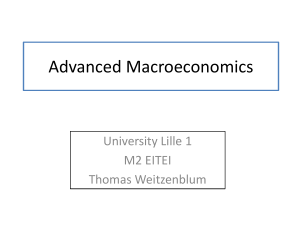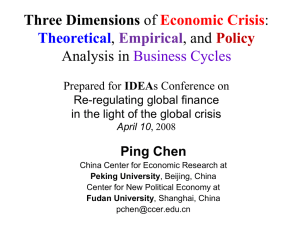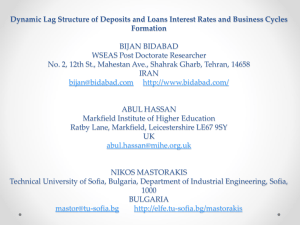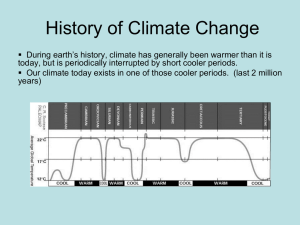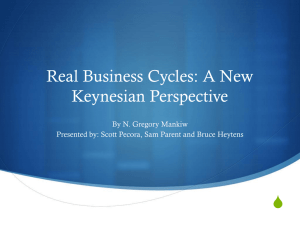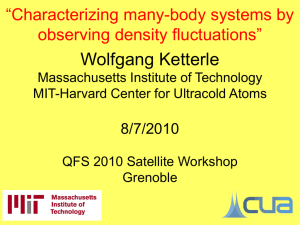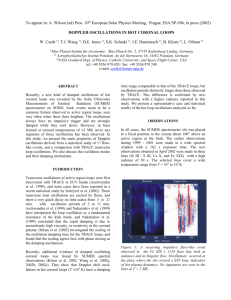Fluctuations/Cycles (SD)
advertisement
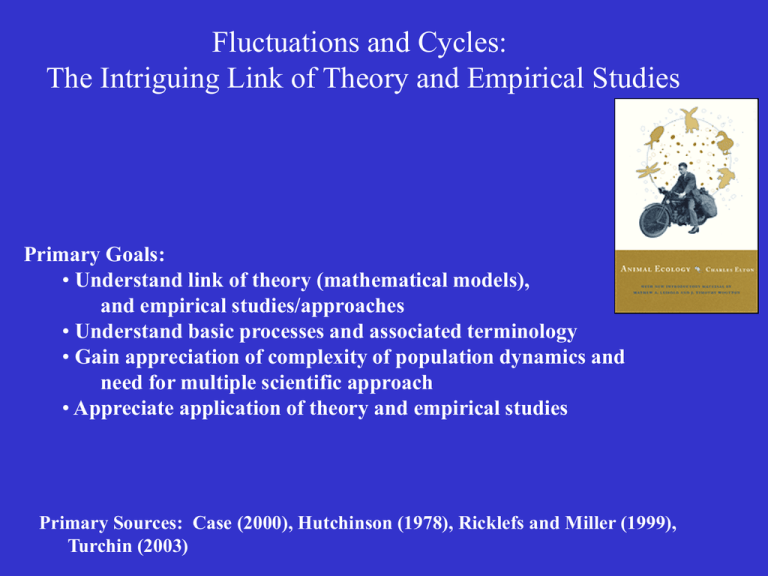
Fluctuations and Cycles: The Intriguing Link of Theory and Empirical Studies Primary Goals: • Understand link of theory (mathematical models), and empirical studies/approaches • Understand basic processes and associated terminology • Gain appreciation of complexity of population dynamics and need for multiple scientific approach • Appreciate application of theory and empirical studies Primary Sources: Case (2000), Hutchinson (1978), Ricklefs and Miller (1999), Turchin (2003) Why Theory? The mathematical/theoretical treatment (Lotka/Volterra/Pearl) of population fluctuations began, coincidentally, with the initiation of a rigorous empirical approach (Elton) Only recently, do we find a syntheses of empirical/theoretical approaches: Turchin’s Complex Population Dynamics perhaps providing the best synthesis Thanks Becky! Theory is key: tendency for common phenomenon to be overlooked or misinterpreted in the absence of a well-known body of theory The primary contribution of theory was in demonstrating that complex dynamics, such as cycles, could be caused by simple endogenous mechanisms: this provided a rationale for developing more clever hypotheses than simply trying to identify exogenous mechanisms, such as weather. With the debate of Density Dependence/Independence, Nicholson started the debate that led to analyses of long-term data sets. From this, emerged the search for analytical methods, discussed by Mary. Emergence of nonlinear dynamic models, and the, once again, link between physicists and ecologists, exemplified by Robert May’s work. Population Dynamics: Terminology Trend: long-term (operationally defined) exogenously driven, systematic change Oscillation: Pop dynamics that have some element of regularity, predictability Damped Oscillation: oscillations that become less pronounced as they approach a stable point (e.g., carrying capacity) Fluctuation: temporal changes in abundance Irregular fluctuations: irregularity of numbers after trend and endogenous oscillations have been removed == “env. stochasticity” ==“process noise” (exogenous env. stochasticity and measurement noise [sampling and measurement error] Cycle: Stable limit cycle: A stable oscillation – never stabilizes at equilibrium Bifurcation: limit cycle that splits into n-periodicity Chaos: bounded fluctuations with sensitive dependence on initial conditions Deterministic Chaos: arises from model without stochasticity Fluctuations and Cycles: Two Focuses Single Species Population Interactions Population Oscillations: Single Species/Spatial Relations Demography of Single Population Metapopulation Dynamics Single-Population Oscillations: Mechanisms Endogenous vs Exogenous vs Intrinsic vs Extrinsic Mechanisms Endogenous: the density-dependent component of population dynamics Exogenous: the density-independent component; affects density without being affected by it Intrinsic factors: pertaining to the focal population; characteristics within Extrinsic factors: external factors (e.g., predation) affecting focal population Single-Population Fluctuations: Mechanisms First Principle: intrinsic growth rate determines theoretical oscillation potential Species(populations) with high pop growth rates can track fluctuating env conditions (K) Single-Population Fluctuations: Mechanisms Single-Population Fluctuations: Mechanisms Characteristic Return Time, T Theory suggests a population will track the environment closely when T is < period of environmental fluctuation/2 AND When T is >> than period than population varies little Single-Population Fluctuations: Mechanisms Second Principal: Temporal variation in age structure will lead to oscillatory behavior Temporal variation often irregular, leading to fluctuations, not cycles Single-Population Cycles: Mechanisms High R and simple density dependence Population models developed in 1920-30s demonstrated that populations subjected to even minor random environmental var could be caused to oscillate or cycle Inherent in discrete population models, such as the logistic equation, N t+1 = (1 + R(1-Nt / K) ) Population Size N(t) 120 100 80 60 N(t) 40 20 31 28 25 22 19 16 13 10 7 4 1 0 Time Lets look at what happens to the predicted N with changes in population growth rate, R Stable Limit Cycles From Case (2000:115) R < 2.0 R = 2.0 R = 2.449 R = 2.544 R = 2.564 R = 2.568 Equilibrium point is locally stable Equilibrium point becomes unstable a cycle of 2 “is born” A cycle of period 4 is born A cycle of period 8 is born A cycle of period 16 is born A cycle of period 32 is born Note: successive period doublings occur faster with inc. R. Converge on R=2.57, in the limit of an infinite period. Single-Population Cycles: Mechanisms Time delays cause oscillations and cycles in continuous models Time lags Continuous time-lag model of Hutchinson (but first used in economics 40 years prior) dn/dt=rNt ( (K-Nt-T )/K) The dynamics of this model are controlled by rT; results are sensitive to either r or T Behavior is well known for relative values of r and T Chaotic Population Growth R > 2.57 Chaotic behavior is NOT random. Note the behavior arises from a deterministic model Deterministic Chaos: arising from a deterministic model (no stochastic elements), sensitive to initial conditions, e.g., No. Note that these behaviors are distinct from the continuous logistic eqn; the only difference is the lag time of t-interval. Single-Population Cycles: Empirical Studies Single-Population Cycles: Empirical Studies Observations and Hypotheses Three Classes of Hypotheses: 1. Abiotic (weather and sunspots) 2. Biotic intrinsic (genotype/phenotypic phys. or behav.) 3. Biotic extrinsic (food, predation, parasites, disease) The Chitty Hypothesis: “all species are capable of limiting their own density without either destroying the food resources to which they are adapted, or depending upon enemies or climatic accidents to prevent them from doing so” “at each mention of the Chitty Hypothesis faculty and students bow their heads and cross themselves to the accompaniment of religious music”


